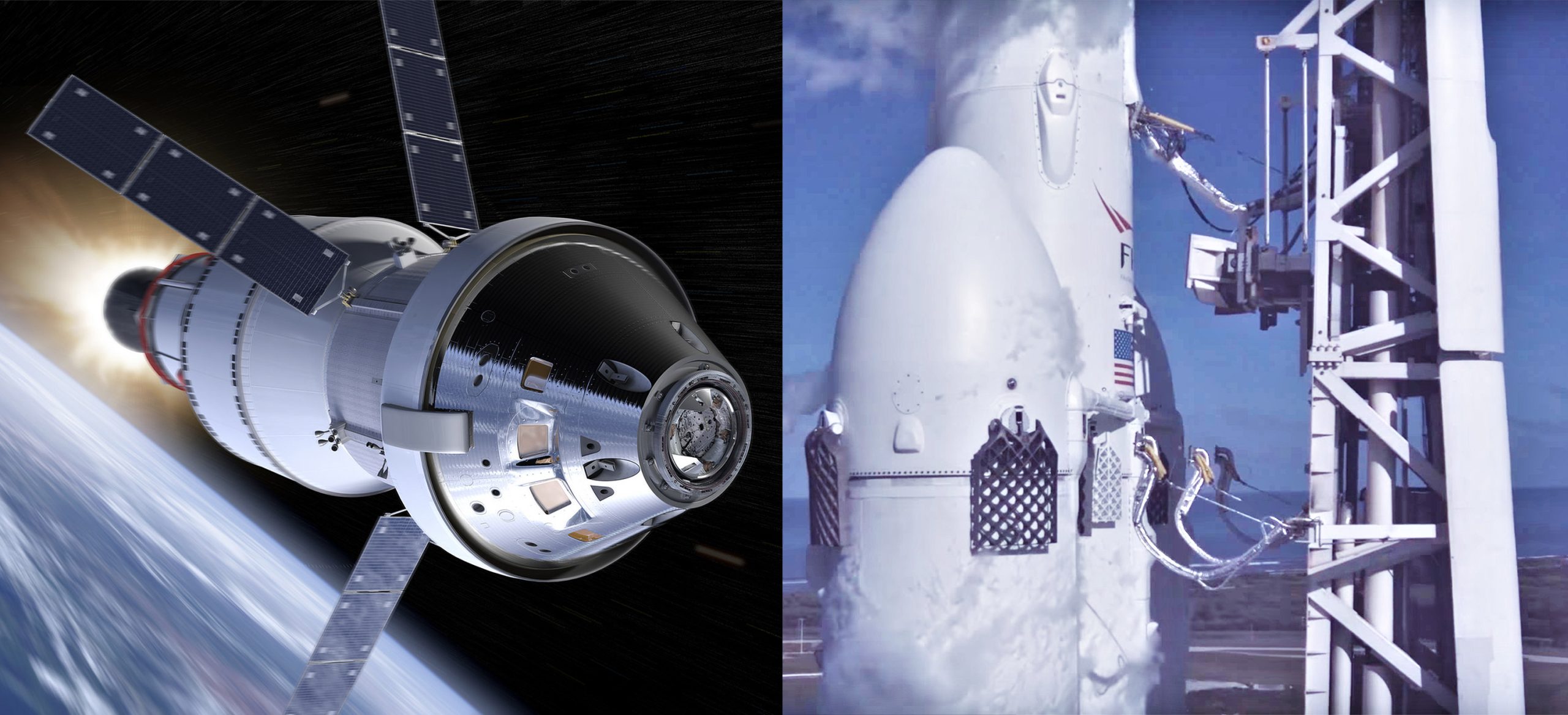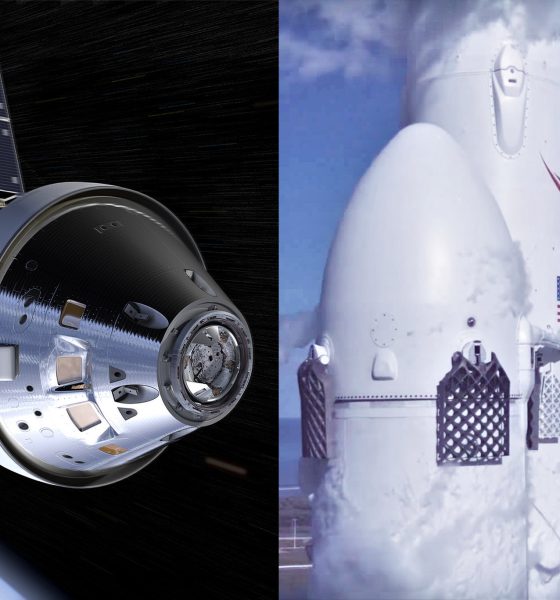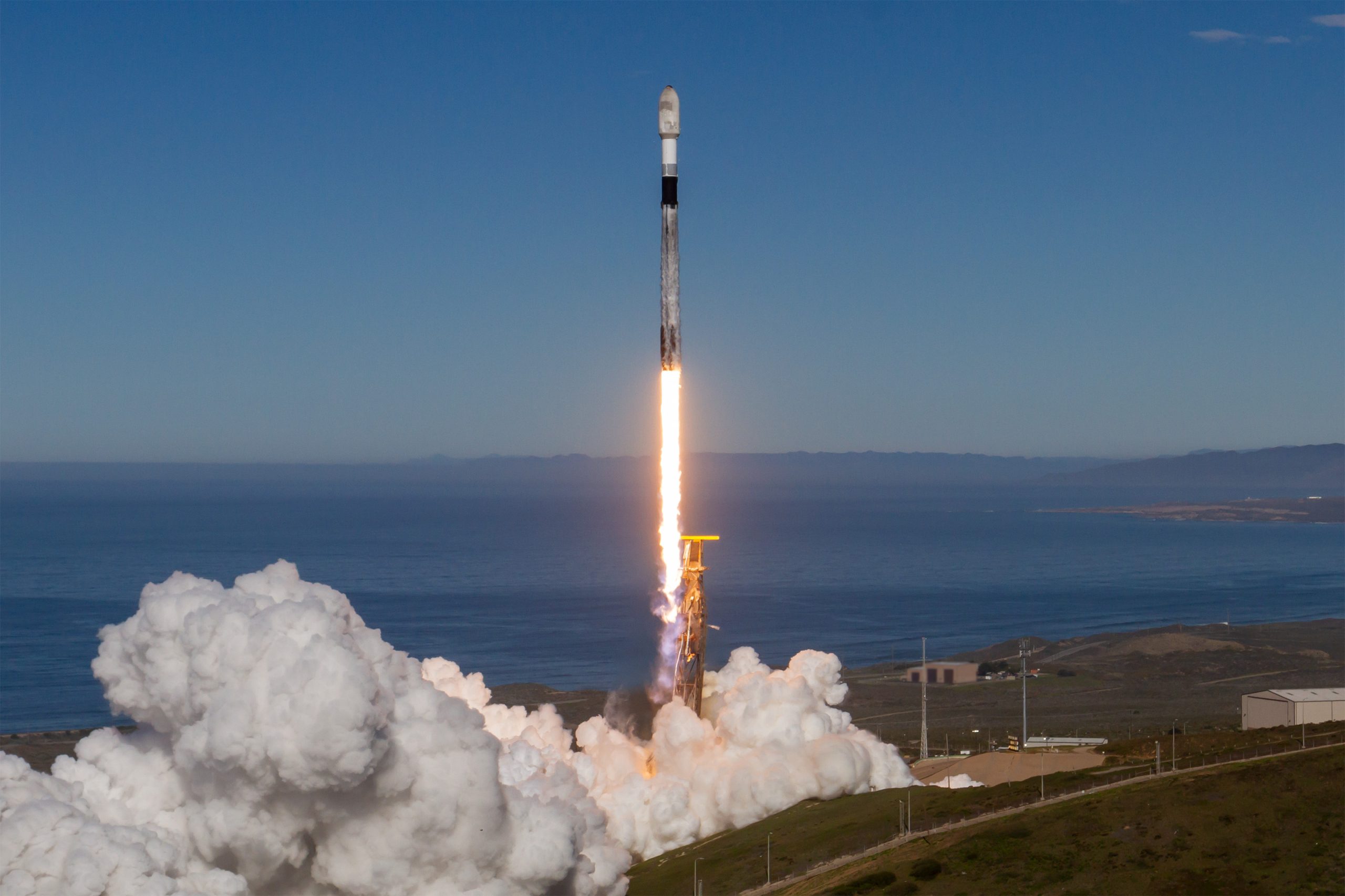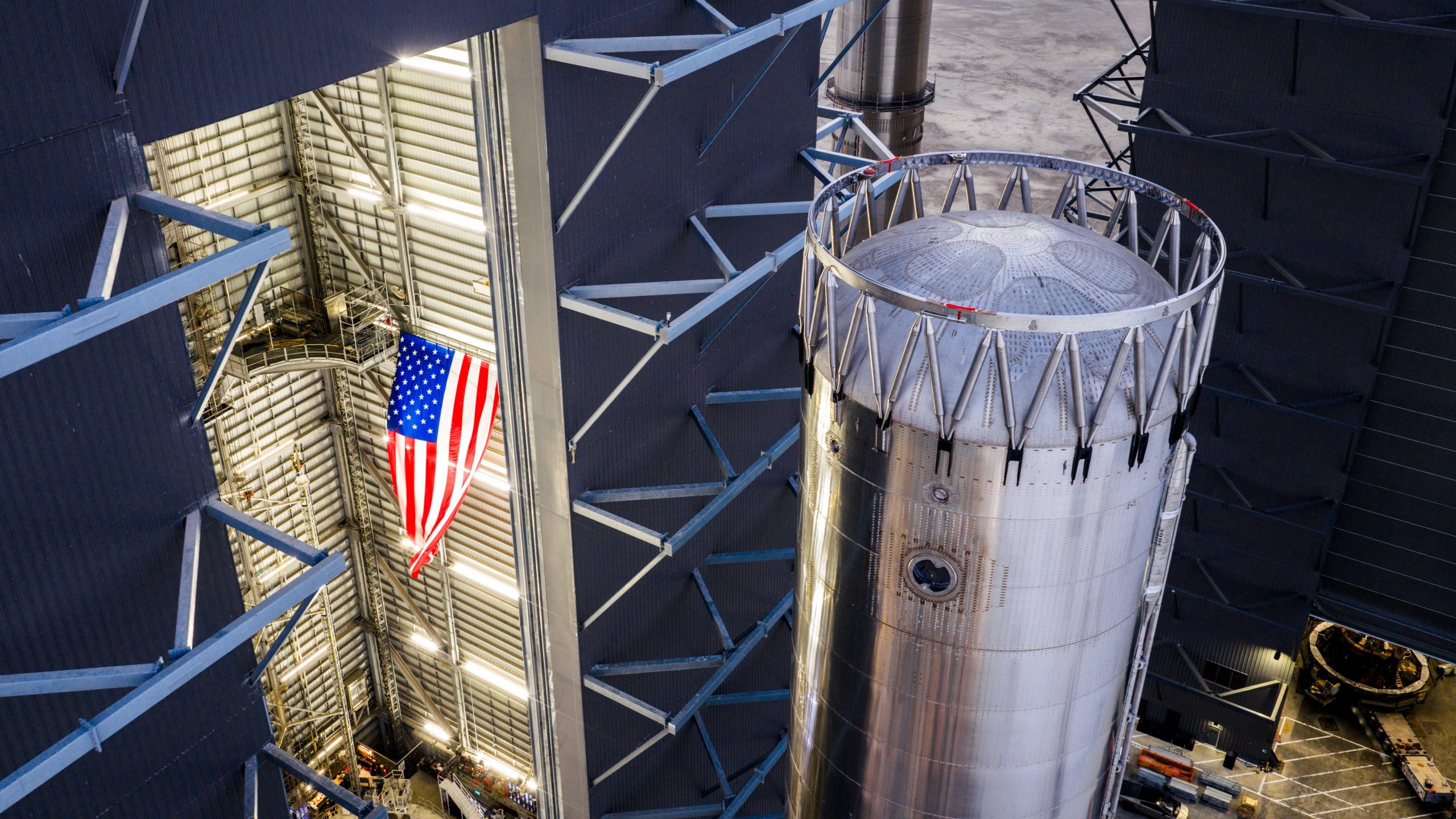

SpaceX
SpaceX’s Falcon Heavy shown launching NASA Orion spacecraft in fan render
A spaceflight fan’s unofficial render has offered the best look yet at what SpaceX’s Falcon Heavy could look like in the unlikely but not impossible event that NASA decides to launch its uncrewed Orion demonstration mission on commercial rockets.
Oddly enough, the thing that most stands out from artist brickmack’s interpretation of Orion and Falcon Heavy is just how relatively normal the large NASA spacecraft looks atop a SpaceX rocket. The render also serves as a visual reminder of just how little SpaceX would necessarily need to change or re-certify before Falcon Heavy would be able to launch Orion. Aside from the fact that NASA’s Launch Services Program (LSP) is not quite ready to certify the full launch vehicle for NASA missions, very few hurdles appear to stand in the way of Orion launching on a commercial rocket – be it on Falcon Heavy or ULA’s Delta IV Heavy.
In a wholly unexpected announcement made by NASA administrator Jim Bridenstine during a March 13th Congressional hearing, the agency leader revealed that NASA was seriously analyzing the possibility of launching Orion’s uncrewed lunar demonstration mission – known as Exploration Mission 1 (EM-1) – on commercial launch vehicles instead of the agency’s own Space Launch System (SLS) rocket.
The purpose: maintain the missions launch schedule – 2020 – in the face of a relentless barrage of delays facing the SLS rocket, the launch debut of which has effectively been slipped almost three years in the last 18 or so months, with the latest launch date now featuring a median target of November 2021. Some subset of NASA leaders, Congressional supporters, and White House officials have clearly begun to accept that SLS/Orion’s major continued delays are simply unacceptable to both the taxpayer and maintaining appearances, despite the fact that those delays continue to make SLS/Orion an extremely successful example of both corporate welfare and a jobs program.
As it currently stands, a median target of November 2021 for the SLS launch debut guarantees that there is almost certainly no chance of the rocket launching at any point in 2020, even if NASA took the extraordinary step of completely cutting a full-length static fire of the entirely unproven rocket prior to its debut. Known as the “Green Run”, the ~8-minute long static fire test is planned to occur at NASA’s Stennis Space Center on the B2 test stand, which NASA – despite continuous criticism from OIG before and after the decision – has spent more than $350M to refurbish. Stennis B2’s refurbishment was effectively completed just two months ago after the better part of seven years of work.
Put simply, even heroics verging on insanity would be unlikely to get SLS prime contractor Boeing to cut ~12 months off of the rocket’s schedule prevent additional unplanned delays in the 18 or so months between now and an even minutely plausible launch debut target. Admittedly, NASA’s proposed commercial alternative for Orion’s lunar launch debut also offers a range of different but equally concerning risks for the program and mission assurance.


Major challenges remain
On one hand, the task of successfully launching NASA’s Orion spacecraft around the Moon with Delta IV Heavy and Falcon Heavy rockets has a lot going for it, regardless of which rockets launch Orion to LEO or launch the fueled upper stage to boost it around the Moon. In 2014, NASA and ULA successfully launched a partial-fidelity Orion spacecraft to an altitude of 3700 miles (~6000 km), testing some of Orion’s avionics, general spacefaring capabilities, and the craft’s heat shield, although Lockheed Martin has since significantly changed the shield’s design and method of production/installation. Regardless, the EFT-1 test flight means that a solution already more or less exists to mate Orion and its service module (ESM) to a commercial rocket and launch the duo into orbit.
If ULA is unable to essentially produce a Delta IV Heavy from scratch in less than 12-18 months, Falcon Heavy would be next in line to launch Orion/ESM, a use-case that might actually be less absurd than it seems. Thanks to the fact that SpaceX’s payload fairing is actually wider than the large Orion spacecraft (5.2 m (17 ft) vs. 5 m (16.5 ft) in diameter), any major risks of radical aerodynamic problems can be largely retired, although that would still need to be verified with models and/or wind-tunnel testing. The only major change that would need to be certified is ensuring that the Falcon second stage is capable of supporting the Orion/ESM payload, weighing at least ~26 metric tons (~57,000 lb) at launch. The heaviest payloads SpaceX has launched thus far were likely its Iridium NEXT missions, weighing around 9600 kg (21,100 lb).
However, the most difficult aspects of Bridenstine’s proposed alternative are centered around the need for the EM-1 Orion spacecraft to somehow dock with a fueled upper stage meant to be launched separately. Orion in its current EM-1 configuration does not currently have the ability to dock with anything on orbit, a challenge that would require Lockheed Martin and subcontractors to find a way to install the proper hardware and computers and develop software that was – prior to this surprise announcement – only planned to fly on EM-3 (NET 2024). As such, Lockheed Martin – notorious for slow progress, cost overruns, and delays throughout the Orion program – would effectively become the critical path in finishing and installing on-orbit docking capabilities on Orion in less than 12-18 months.
The only alternative would be to have either SpaceX or ULA retrofit some sort of docking mechanism onto one of their upper stages, perhaps less difficult than getting Lockheed Martin to work expediently but still a major challenge for such a short developmental timeframe. Put simply, completing the tasks at hand in the time allotted could easily be beyond the capabilities of old-guard NASA contractors like LockMart and Boeing. Ironically, the upper stage that was designed for EM-1 and is already more or less complete – known as the interim cryogenic propulsion stage (ICPS) – is built by Boeing, the same company that has the most to lose if NASA chooses to make the SLS rocket – which Boeing also builds – functionally redundant with a commercial dual-launch alternative.
Second render in this series. Commercial transport for Orion from LEO to TLI in a dual-launch profile (this part is much harder in the near term, really need ACES unless the goal is only a flyby) https://t.co/70eG2i7Axz— Mack Crawford (@brickmack) March 24, 2019

With
Check out Teslarati’s Marketplace! We offer Tesla accessories, including for the Tesla Cybertruck and Tesla Model 3.

Elon Musk
Elon Musk gives nod to SpaceX’s massive, previously impossible feat
It was the booster’s 30th flight, a scenario that seemed impossible before SpaceX became a dominant force in spaceflight.

Elon Musk gave a nod to one of SpaceX’s most underrated feats today. Following the successful launch of the Transporter-15 mission, SpaceX seamlessly landed another Falcon 9 booster on a droneship in the middle of the ocean.
It was the booster’s 30th flight, a scenario that seemed impossible before SpaceX became a dominant force in spaceflight.
Elon Musk celebrates a veteran Falcon 9 booster’s feat
SpaceX completed another major milestone for its Smallsat Rideshare program on Friday, successfully launching and deploying 140 spacecraft aboard a Falcon 9 from Vandenberg Space Force Base. The mission, known as Transporter-15, lifted off two days later than planned after a scrub attributed to a ground systems issue, according to SpaceFlight Now. SpaceX confirmed that all payloads designed to separate from the rocket were deployed as planned.
The Falcon 9 used for this flight was booster B1071, one of SpaceX’s most heavily flown rockets. With its 30th mission completed, it becomes the second booster in SpaceX’s fleet to reach that milestone. B1071’s manifest includes five National Reconnaissance Office missions, NASA’s SWOT satellite, and several previous rideshare deployments, among others. Elon Musk celebrated the milestone on X, writing “30 flights of the same rocket!” in his post.
Skeptics once dismissed reusability as unfeasible
While rocket landings are routine for SpaceX today, that was not always the case. Industry veterans previously questioned whether reusable rockets could ever achieve meaningful cost savings or operational reliability, often citing the Space Shuttle’s partial reusability as evidence of failure.
In 2016, Orbital ATK’s Ben Goldberg argued during a panel that even if rockets could be reusable, they do not make a lot of sense. He took issue with Elon Musk’s claims at the time, Ars Technica reported, particularly when the SpaceX founder stated that fuel costs account for just a fraction of launch costs.
Goldberg noted that at most, studies showed only a 30% cost reduction for low-Earth orbit missions by using a reusable rocket. “You’re not going to get 100-fold. These numbers aren’t going to change by an order of magnitude. They’re just not. That’s the state of where we are today,” he said.
Former NASA official Dan Dumbacher, who oversaw the Space Launch System, expressed similar doubts in 2014, implying that if NASA couldn’t make full reusability viable, private firms like SpaceX faced steep odds.
Elon Musk
SpaceX’s Starship program is already bouncing back from Booster 18 fiasco
Just over a week since Booster 18 met its untimely end, SpaceX is now busy stacking Booster 19, and at a very rapid pace, too.

SpaceX is already bouncing back from the fiasco that it experienced during Starship Booster 18’s initial tests earlier this month.
Just over a week since Booster 18 met its untimely end, SpaceX is now busy stacking Booster 19, and at a very rapid pace, too.
Starship V3 Booster 19 is rising
As per Starbase watchers on X, SpaceX rolled out the fourth aft section of Booster 19 to Starbase’s MegaBay this weekend, stacking it to reach 15 rings tall with just a few sections remaining. This marks the fastest booster assembly to date at four sections in five days. This is quite impressive, and it bodes well for SpaceX’s Starship V3 program, which is expected to be a notable step up from the V2 program, which was retired after a flawless Flight 11.
Starship watcher TankWatchers noted the tempo on X, stating, “During the night the A4 section of Booster 19 rolled out to the MegaBay. With 4 sections in just 5 days, this is shaping up to be the fastest booster stack ever.” Fellow Starbase watcher TestFlight echoed the same sentiments. “Booster 19 is now 15 rings tall, with 3 aft sections remaining!” the space enthusiast wrote.
Aggressive targets despite Booster 18 fiasco
SpaceX’s V3 program encountered a speed bump earlier this month when Booster 18, just one day after rolling out into the factory, experienced a major anomaly during gas system pressure testing at SpaceX’s Massey facility in Starbase, Texas. While no propellant was loaded, no engines were installed, and no one was injured in the incident, the unexpected end of Booster 18 sparked speculation that the Starship V3 program could face delays.
Despite the Booster 18 fiasco, however, SpaceX announced that “Starship’s twelfth flight test remains targeted for the first quarter of 2026.” Elon Musk shared a similar timeline on X earlier this year, with the CEO stating that “ V3 is a massive upgrade from the current V2 and should be through production and testing by end of year, with heavy flight activity next year.”
Considering that Booster 19 seems to be moving through its production phases quickly, perhaps SpaceX’s Q1 2026 target for Flight 12 might indeed be more than feasible.
Elon Musk
Elon Musk shares SpaceX’s directive that destroys a prevalent media narrative
Musk’s comments followed Starlink’s initiatives for people affected by severe flooding in Indonesia and Cyclone Ditwah in Sri Lanka.

Elon Musk recently shared SpaceX’s standing policy to offer free Starlink service during natural disasters worldwide, highlighting the company’s commitment to pursue aid over profit during times of need.
Musk’s comments followed Starlink’s initiatives for people affected by severe flooding in Indonesia and Cyclone Ditwah in Sri Lanka.
Starlink activates free service in Indonesia and Sri Lanka
Starlink recently announced free service for those impacted by severe flooding in Indonesia’s Sumatra region, partnering with the government to deploy terminals rapidly to the hardest-hit areas. The offer extends to new and existing customers through December, restoring connectivity in zones where traditional networks have failed due to infrastructure damage.
Musk quoted the post on X, writing, “SpaceX standard policy is to make Starlink free whenever there is a natural disaster somewhere in the world. It would not be right to profit from misfortune.”
Starlink extended the same relief to Sri Lanka amid Cyclone Ditwah, coordinating with local authorities for additional support. The cyclone battered the island nation with heavy rains and winds, disrupting communications for thousands. Free access also lasts until year-end, emphasizing Starlink’s role in bridging gaps during crises.
“For those affected by the severe flooding in Indonesia and Sri Lanka in the aftermath of Cyclone Ditwah, Starlink is providing free service to new and existing customers through the end of December 2025. We’re also working with the Indonesian government to rapidly deploy terminals and restore connectivity to the hardest-hit areas on Sumatra, as well as with the Sri Lankan government to provide additional assistance,” Starlink wrote in a post on its official website.
Musk’s companies routinely provide aid
Musk’s firms have a track record of providing critical support in crises, often without fanfare, challenging portrayals of him as a comic book villain intent on enriching himself on the backs of a suffering populace. In January 2024 alone, Tesla opened Superchargers for free in Japan’s Hokuriku region after a magnitude 7.6 earthquake killed at least 55 and injured hundreds.
Similar efforts include Starlink deployments for the 2023 Maui wildfires, 2024 Hurricane Helene in North Carolina, and floods in Texas, where the service was used to help facilitate emergency coordination. These actions, which total millions in waived fees and logistics, demonstrate a proactive ethos among Musk’s companies, with Musk noting in past interviews that such aid stems from engineering solutions over optics.
The initiatives also provide a direct rebuttal of Musk’s characterization on mainstream media, which tends to lean negatively. This has become much more notable in recent years as Musk adopted more conservative policies. These negative sentiments came to a head earlier this year when Tesla stores, vehicles, and even some owners, were attacked during waves of anti-Tesla protests.










